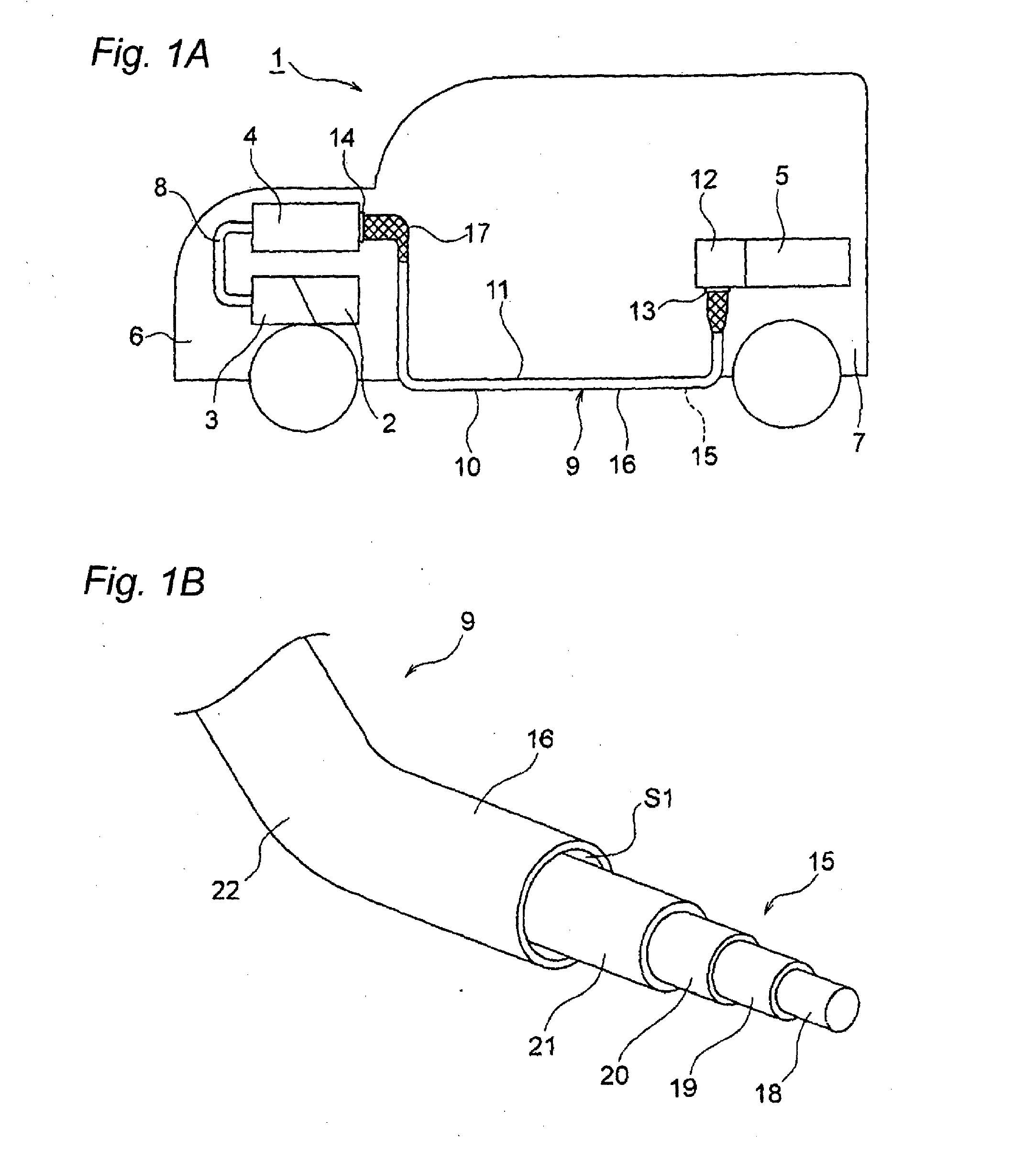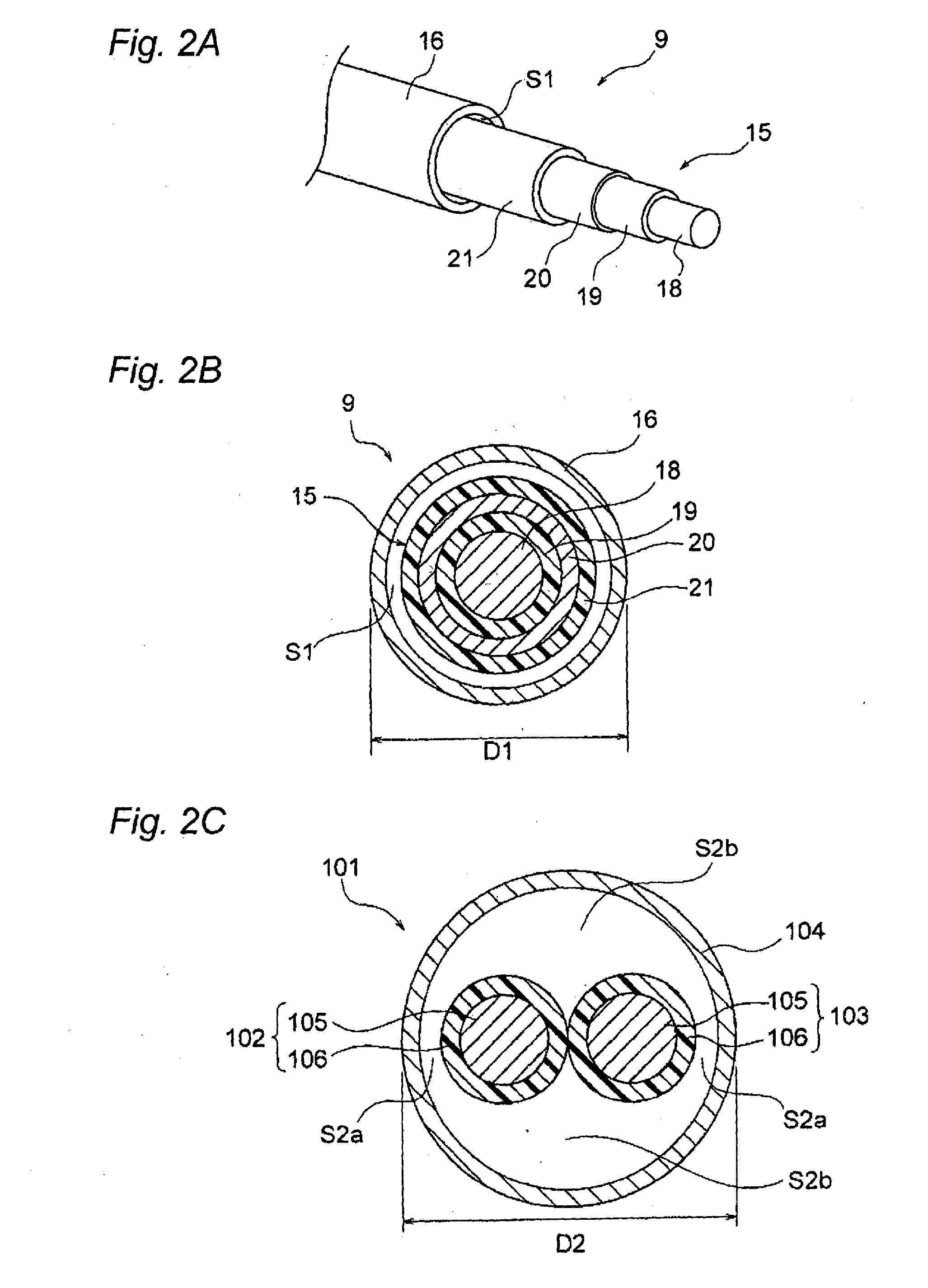Wire harness
a wire harness and wire technology, applied in the direction of insulated conductors, cables, conductors, etc., can solve the problems of wire harness damage, thick conductor paths,
- Summary
- Abstract
- Description
- Claims
- Application Information
AI Technical Summary
Benefits of technology
Problems solved by technology
Method used
Image
Examples
first embodiment
[0076]In FIGS. 3A to 3B, a wire harness 31 is a high voltage member and includes a coaxial conducting wire 32 and an covering member 33. Although unillustrated, the electromagnetic shield member is assumed to be identical with; for instance, the electromagnetic shield member described in connection with the
[0077]The coaxial conducting wire 32 is configured so as to include three paths (triple circuitry) in the form of a single wire. Specifically, the coaxial conducting wire 32 includes a first conducting path 34 that is situated at a center of the coaxial conducting wire 32 and that assumes a circular cross sectional profile; a first insulator 35 that sheathes an outer periphery of the first conducting path 34 in a predetermined thickness; a second conducting path 36 laid outside the first insulator 35; a second insulator 37 that sheathes an outer periphery of the second conducting path 36 in a predetermined thickness; a third conducting path 38 laid outside the second insulator 37;...
third embodiment
[0093]A third embodiment is hereunder described by reference to the drawings. FIGS. 4A to 4C are schematic illustrations of a wire harness that is to be still another example.
[0094]In FIG. 4A, a wire harness 51 is a high voltage member and includes the electromagnetic shield member 17, a coaxial conducting wire 52, and an covering member 53.
[0095]The coaxial conducting wire 52 is configured so as to include two paths (double circuitry) in the form of a single wire. The coaxial conducting wire 52 is also configured in such a way that the electromagnetic shield member 17 coaxial to the two circuits is disposed outside the two circuits. Specifically, the coaxial conducting wire 52 is configured by inclusion of the first conducting path 18 that is situated at the center of the coaxial conducting wire 52 and that has a circular cross sectional profile, the first insulator 19 that sheathes the outer periphery of the first conducting path 18 in a predetermined thickness, the second conduct...
fourth embodiment
[0107]A fourth embodiment is hereunder described by reference to the drawings. FIGS. 5A to 5C are schematic illustrations of a wire harness that is to be an exemplary modification of the wire harness shown in FIGS. 4A to 4C.
[0108]In FIG. 5A, a wire harness 71 is materialized by making a change to the covering member of the wire harness 51 of the third embodiment. Specifically, the wire harness 71 is configured by inclusion of the coaxial conducting wire 52 in close contact with the exterior surface of the second insulator 21 and a covering member 72.
[0109]The covering member 72 is a tubular body made of a resin, or a resin tubular body, and formed so as to assume a length required to accommodate the coaxial conducting wire 52 and a thickness required to protect the coaxial conducting wire 52. The covering member 72 is formed so as to assume a circular cross sectional profile. The cross sectional profile is a mere example and may also be an ellipsoidal shape, an oval shape, or a rect...
PUM
 Login to View More
Login to View More Abstract
Description
Claims
Application Information
 Login to View More
Login to View More - R&D
- Intellectual Property
- Life Sciences
- Materials
- Tech Scout
- Unparalleled Data Quality
- Higher Quality Content
- 60% Fewer Hallucinations
Browse by: Latest US Patents, China's latest patents, Technical Efficacy Thesaurus, Application Domain, Technology Topic, Popular Technical Reports.
© 2025 PatSnap. All rights reserved.Legal|Privacy policy|Modern Slavery Act Transparency Statement|Sitemap|About US| Contact US: help@patsnap.com



